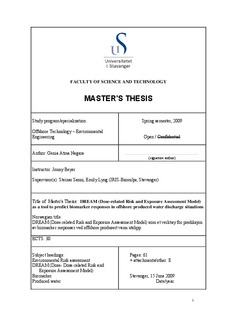| dc.contributor.author | Nagara, Genia Atma | |
| dc.date.accessioned | 2009-11-25T09:23:13Z | |
| dc.date.issued | 2009-11-25 | |
| dc.identifier.uri | http://hdl.handle.net/11250/182440 | |
| dc.description | Master's thesis in Environmental technology | en |
| dc.description.abstract | Every year, approximately 200 million tones of produced water are discharged into the sea by the Norwegian oil industry. Although rapidly diluted, due to its large amount and possible long term (chronic) effects, the environmental risk of produced water discharge has been investigated widely. The risk prediction model called DREAM (Dose-related Risk and Exposure Assessment Model) has been used for environmental risk assessment of produced water discharges. Biological markers or so-called ‘biomarkers’, have been proposed as a suitable tool for pollutant-effect-monitoring of the discharges from the offshore industry. However, the links between environmental risk model predictions and biomarker responses in produced water exposed animals are still not clearly defined. Therefore, the objective of this study is to investigate the feasibility of linking these two risk tools for the purpose of enabling prediction of environmental risk which can be monitored.
In practice, this is done by employing the DREAM model not only to perform a general risk assessment but also to predict the biomarker responses of produced water discharge and then compare the results with the biomarkers responses measured in a field survey. The link between the model and biomarker response is established using the species sensitivity distribution (SSD) approach.
From the results, it is shown that predicting biomarker responses using the DREAM model was feasible by applying some assumptions and simplifications. The model could also predict a similar trend with the observation responses at different stations. In this case, the predicted biomarker responses give about 14% higher value compared to observation, which is related to the conservative approach (based on the maximum risk value) applied in the model and therefore the model cannot accommodate the duration variable in the biomarker response formation and recovery processes which may differ in biomarkers.
Despite the remaining uncertainties and limitations, especially in relation with the model limitations, reliability of the SSD approach and also the available field data, this study could provide some essential basis for the study of linking the risk prediction with risk monitoring | en |
| dc.format.extent | 895529 bytes | |
| dc.format.mimetype | application/pdf | |
| dc.language.iso | eng | en |
| dc.publisher | University of Stavanger, Norway | en |
| dc.relation.ispartofseries | Masteroppgave/UIS-TN-IMN/2009 | en |
| dc.subject | offshore teknologi | en |
| dc.subject | teknisk miljøvern | en |
| dc.subject | environmental risk assessment | en |
| dc.subject | DREAM (Dose-related Risk and Exposure Assessment Model) | en |
| dc.subject | biomarker | en |
| dc.subject | produced water | en |
| dc.title | DREAM (Dose-related Risk and Exposure Assessment Model) as a tool to predict biomarker responses in offshore produced water discharge situations | en |
| dc.type | Master thesis | en |
| dc.subject.nsi | VDP::Technology: 500::Environmental engineering: 610 | en |
